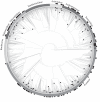Repeated evolution of salt-tolerance in grasses
- PMID: 23445947
- PMCID: PMC3639779
- DOI: 10.1098/rsbl.2013.0029
Repeated evolution of salt-tolerance in grasses
Abstract
The amount of salt-affected agricultural land is increasing globally, so new crop varieties are needed that can grow in salt-affected soils. Despite concerted effort to develop salt-tolerant cereal crops, few commercially viable salt-tolerant crops have been released. This is puzzling, given the number of naturally salt-tolerant grass species. To better understand why salt-tolerance occurs naturally but is difficult to breed into crop species, we take a novel, biodiversity-based approach to its study, examining the evolutionary lability of salt-tolerance across the grass family. We analyse the phylogenetic distribution of naturally salt-tolerant species on a phylogeny of 2684 grasses, and find that salt-tolerance has evolved over 70 times, in a wide range of grass lineages. These results are confirmed by repeating the analysis at genus level on a phylogeny of over 800 grass genera. While salt-tolerance evolves surprisingly often, we find that its evolution does not often give rise to a large clade of salt-tolerant species. These results suggest that salt-tolerance is an evolutionarily labile trait in grasses.
Figures

Comment in
-
Possible role of soil alkalinity in plant breeding for salt-tolerance.Biol Lett. 2013 Aug 7;9(5):20130566. doi: 10.1098/rsbl.2013.0566. Print 2013 Oct 23. Biol Lett. 2013. PMID: 23925836 Free PMC article. No abstract available.
-
Soil alkalinity and salt tolerance: adapting to multiple stresses.Biol Lett. 2013 Aug 7;9(5):20130642. doi: 10.1098/rsbl.2013.0642. Print 2013 Oct 23. Biol Lett. 2013. PMID: 23925838 Free PMC article. No abstract available.
References
-
- Godfray HCJ, et al. 2010. Food security: the challenge of feeding 9 billion people. Science 327, 812–81810.1126/science.1185383 (doi:10.1126/science.1185383) - DOI - DOI - PubMed
-
- Tester M, Langridge P. 2010. Breeding technologies to increase crop production in a changing world. Science 327, 818–82210.1126/science.1183700 (doi:10.1126/science.1183700) - DOI - DOI - PubMed
-
- Rozema J, Flowers T. 2008. Crops for a salinized world. Science 322, 1478–148010.1126/science.1168572 (doi:10.1126/science.1168572) - DOI - DOI - PubMed
-
- Flowers TJ. 2004. Improving crop salt-tolerance. J. Exp. Biol 55, 307–319 - PubMed
-
- Witcombe JR, Hollington PA, Howarth CJ, Reader S, Steele KA. 2008. Breeding for abiotic stresses for sustainable agriculture. Phil. Trans. R. Soc. B 363, 703–71610.1098/rstb.2007.2179 (doi:10.1098/rstb.2007.2179) - DOI - DOI - PMC - PubMed
Publication types
MeSH terms
Substances
LinkOut - more resources
Full Text Sources
Other Literature Sources
